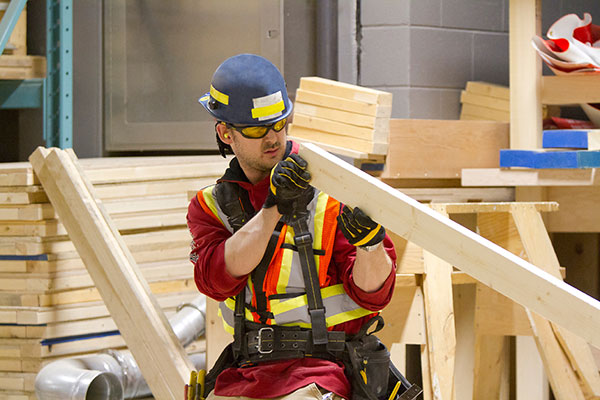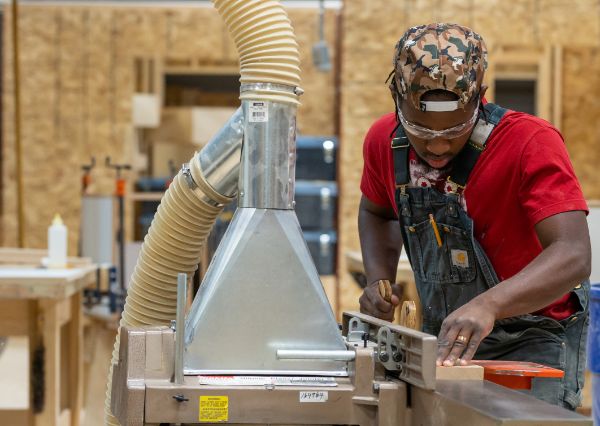On this page:
Overview
Learn to construct, renovate, erect and repair buildings and other structures made of wood, wood substitutes, steel and other materials.
You'll work in residential, commercial or industrial jobs reading drawings or getting instructions before doing layout, materials selection, planning sequences and methods of work. You'll measure and mark materials before cutting and shaping materials, join your materials with nails, screws, bolts or glue and check to make sure your work is level, square, plumb and the right size, shape and location.
In residential work, you will crib basements, build house frameworks, walls, roofs, exterior and interior finishes, and install doors, windows, flooring, cabinets, stairs, handrails, panelling and moulding. You may work with renovations, where you will repair and remodel existing structures.
In commercial or industrial work, you will assemble concrete forms, erect scaffolding, and build bridges, trestles, tunnels, shelters, towers and other structures.
Carpenters are skilled tradespeople who are self-motivated and enjoy working collaboratively with others. This line of work is most fulfilling for those who enjoy working with their hands and in various environments.
To thrive in this career, it is important to have the following traits:
- be creative and have the ability to come up with unique solutions
- have strong problem-solving skills
- possess good verbal and written communication skills
- be proficient in using computers
- have the ability to quickly and accurately solve arithmetic problems
- be collaborative and adaptable to a team environment
- be physically capable of standing, crouching, and kneeling for extended periods
- possess good manual dexterity and balance for working on scaffolding and using proper lifting techniques
- have a strong commitment to safe work habits.
Upon successfully completing the required working hours and apprenticeship education periods, graduates will be awarded an advanced diploma in addition to journeyperson status by Alberta’s Apprenticeship and Industry Training.
Carpentry is a Red Seal Endorsed trade – a recognizable standard that allows tradespeople to work across Canada.
Careers and opportunities
Our graduates may work in the following occupations. Some careers require additional experience and education.
Associated National Occupational Classification (NOC) codes: 70010, 70011, 72310, 72311, 72013.
Apprenticeship training
The term for apprenticeship for a carpenter is four years (four 12-month periods), including a minimum of 1560 hours of on-the-job training and eight weeks of apprenticeship education each year.
Year 1 | Period 1
You will start by learning standard workplace safety and building materials. You will then learn tools, site preparation, building layouts, foundations and floor frame systems, residential drawing, and interpretation.
Training length: 8 weeks
Year 2 | Period 2
You will then learn frame structures, wood frame roofs, interior and exterior finishes, wood stairs as well as light commercial estimating and drawing interpretations.
Training length: 8 weeks
Year 3 | Period 3
You will then learn concrete and building layouts, commercial formwork, commercial interiors and exteriors, and commercial estimating and drawing interpretations.
Training length: 8 weeks
Year 4 | Period 4
You will learn workplace organization, interior finishes, advanced roof framing and stairs, renovations, building design, energy efficiency, building science, industrial estimating and drawing interpretations.
Training length: 8 weeks
Apprenticeship education performance
You must pass each section of the course and the AIT exam to succeed in apprenticeship education.
The passing grade for each period is no less than 50% in each course with no less than a 65% average overall. A passing mark on each provincial exam and the interprovincial qualification (Red Seal Exam) is 70%.
View Alberta's Apprenticeship and Industry Training procedures
Training pathways
You can earn your journeyperson designation in the following way.
The traditional training pathway begins with finding a job with an employer willing to indenture you as an apprentice. Once you are an apprentice, you will alternate between on-the-job training and educational periods.
You must apply for an apprenticeship through Alberta Apprenticeship and Industry Training before attending your first education period at SAIT.

Pre-employment pathway
SAIT’s Pre-employment Carpenter program prepares you to enter into an apprenticeship with hands-on skills. Upon successfully completing the program, you’ll qualify to challenge the first-year Carpenter apprenticeship exam.
Pre-employment CarpenterAdmission requirements
To enter an apprenticeship, you must have the educational qualifications required or recommended education for the trade to which you apply.
Entrance requirements are monitored and set by Alberta Apprenticeship and Industry Training.
Minimum requirements
Successful completion of the following courses:
- English 10-2
- Math 10-3
OR
A pass mark in all five Canadian General Educational Development (GED) tests
OR
Alberta Apprenticeship and Industry Training Entrance Exam.
Recommended requirements
Apprentices with an Alberta High School Diploma that includes the following courses:
- English 30-2
- Math 30-3
- Physics 20 OR Chemistry 20 OR Science 20
- Related career and technology studies (CTS) courses

MyTradeSecrets
Once you have begun working as an apprentice, you can attend SAIT to complete your technical training.
You'll register for technical training at SAIT on MyTradeSecrets or you can register by phone.
How to registerAvailable intakes
Costs
2024/25 tuition and fees
The following costs are effective as of July 1, 2024.
Books or modules, along with other items for classes, are approximately $600 per period.
It's recommended you don't purchase books or modules ahead of time as they might be outdated by the time you attend classes, and they cannot be returned to the Bookstore.
Personal protective equipment (PPE) will be required for the program, which may be an additional cost to apprentices.
2023/24 tuition and fees
The following costs are effective until June 30, 2024.

Funding options for apprentices
Apprentices get to learn while they earn, but there are still costs to consider. Many resources are available at SAIT and federally to help support apprentices.
Financial aidInformation sessions
Prepare for a strong start in your chosen program or get the details you need to decide your future path.
Our expert staff and faculty are ready to answer your questions and provide information about the following:
- What sets SAIT apart
- An introduction to the program and area of study
- Admission requirements
- Future career paths
- Information on the earning potential and graduate employment rates.
Contact
Have more questions?
Apprenticeship training and registration
Apprenticeship and Industry Training Client Services
